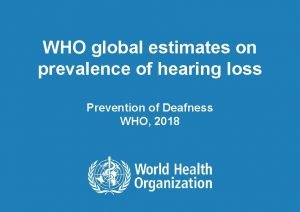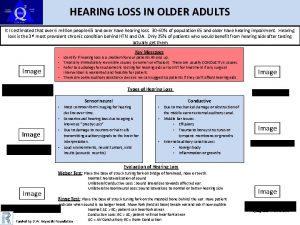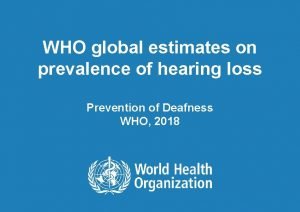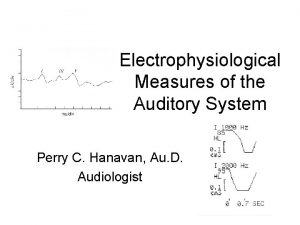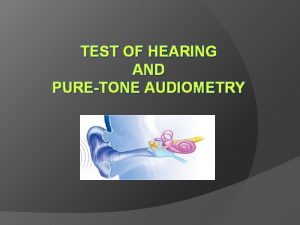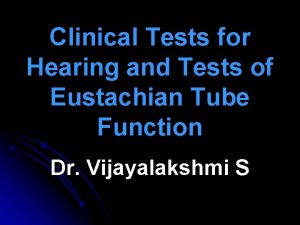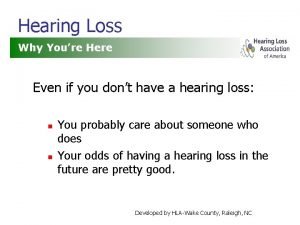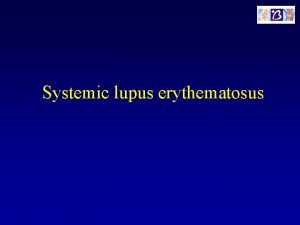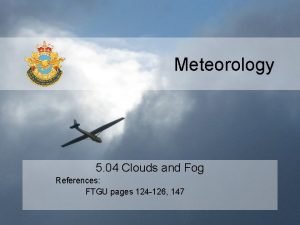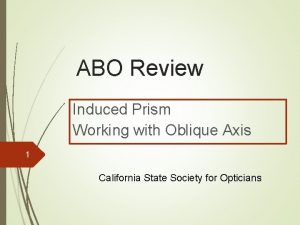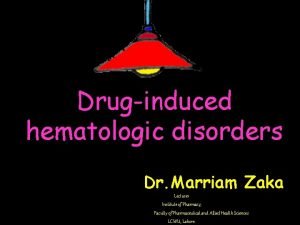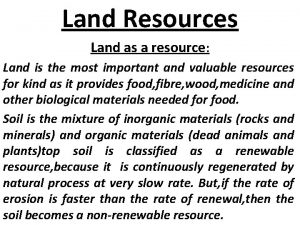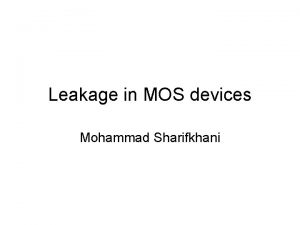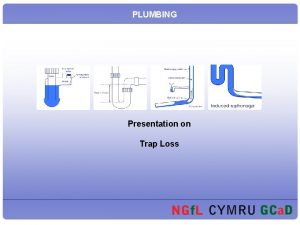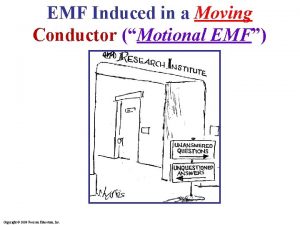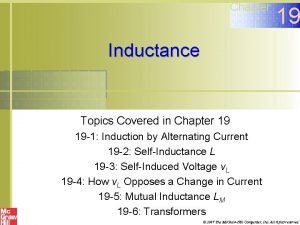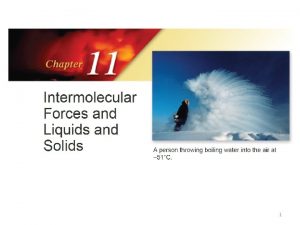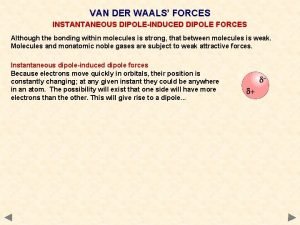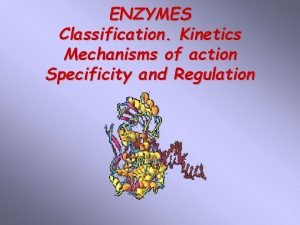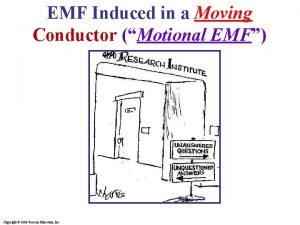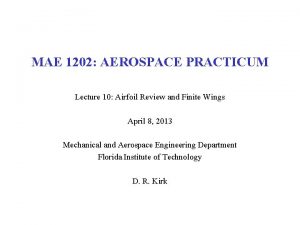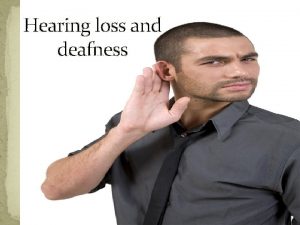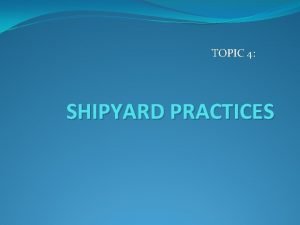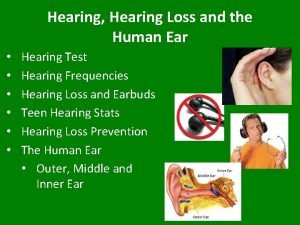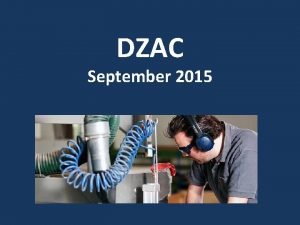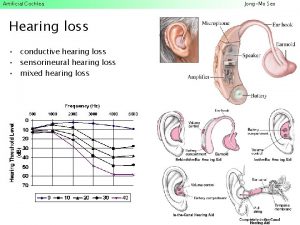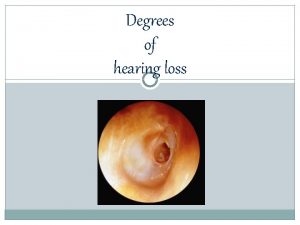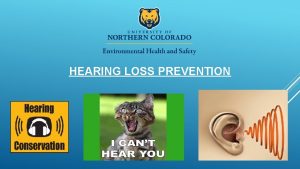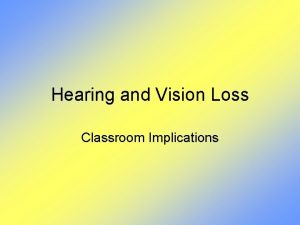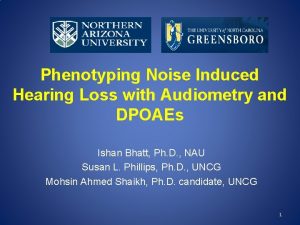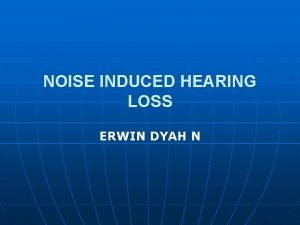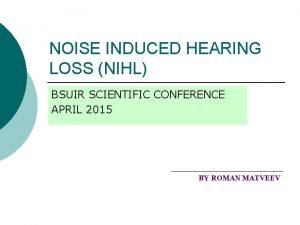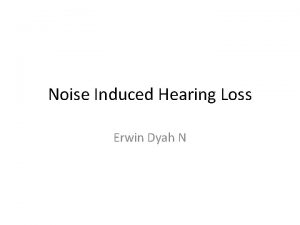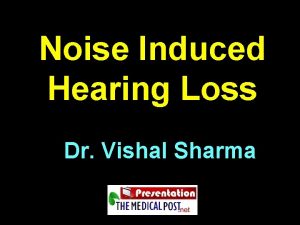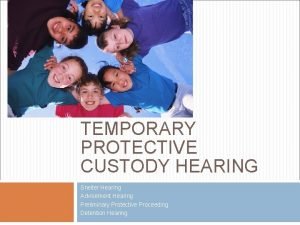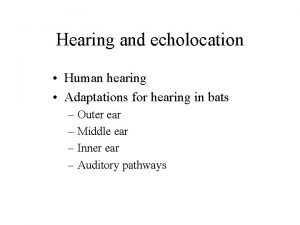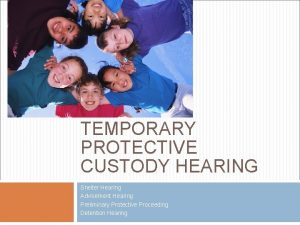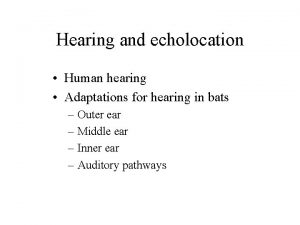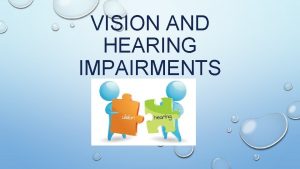Chemical Induced Hearing Loss Among Shipyard Workers LCDR


































- Slides: 34

Chemical Induced Hearing Loss Among Shipyard Workers LCDR N. Cody Schaal, Ph. D. CIH, CSP Assistant Professor/PMB Department Uniformed Services University of the Health Sciences SDAIHA PDS 2017 Nicholas. schaal@usuhs. edu (W) 301 -319 -6988

Disclaimer The contents of this presentation are the sole responsibility of the speaker and do not necessarily reflect the views, assertions, opinions or policies of the Uniformed Services University of the Health Sciences (USUHS), the Department of Defense (Do. D), or the Departments of the Army, Navy, or Air Force. Mention of trade names, commercial products, or organizations does not imply endorsement by the U. S. Government. 2

Overview • Background and Significance • Purpose of Research/Definitions • Historical Studies • Methods • Results • Discussion 3

Background and Significance • 36 million Americans have hearing loss w/ 1 of every 3 classified as NIHL (NIH) • 3 rd most common chronic condition after arthritis and heart disease (NIH) • 31 million Americans exposed to dangerous noise levels and 9 million exposed to hearing damaging chemicals (Fausti et. al. , 2005) • Occupational hearing loss and tinnitus most frequently occurring service connected disabilities among Do. D (Veteran’s Affairs, 2016) • ~2. 5 million disability cases for FY 15 • ~250, 000 new cases per year 4

Problem/Population at Risk • Chemicals may damage hearing by cochlear hair cell and central nervous system impairment (Campo et al. , 2009) • Chemicals alone or in combination with noise • Workers exposed to three hazardous agents simultaneously (Franks et al. , 1996) • Strong evidence of hearing damaging effects for organic solvents (i. e. toluene, xylene, styrene, among others) • Limited study of hearing damaging effects for heavy metals (i. e. lead, manganese, cadmium, arsenic, among others). • No regulations promulgated explicitly to control hearing loss from chemical exposure 5

Purpose of the Research • Investigation focused on chemical concentration’s role in hearing loss • Specific Aim 1: Determine odds of developing a permanent threshold shift (PTS) from exposure to metal (lead, cadmium, arsenic), solvent (toluene and xylene), and noise • Specific Aim 2: Quantify level of hearing loss across 500 -6000 Hz due to metal (lead, cadmium, arsenic), solvent (toluene and xylene), and noise compared to a noise only exposed group 6

Ototoxic Substances • Definition: chemicals toxic to the auditory system affecting hearing/balance (Campo et al. , 2009) • Drugs • Solvents (cont) • Xylenes • Jet Fuels • Antibiotics • Trichloroethylene • Anti-neoplastic drugs • Metals • Loop diuretics • Lead • Solvents • Mercury • Toluene • Tin • Styrene • Cadmium • Ethylbenzene • Arsenic • Manganese 7

Human Studies: Metals • Relationship between hearing loss, solvents, metals, noise • Odds Ratio (OR)=2. 15 organic solvent/OR=1. 64 metal exposed (Choi, 2014) • Worse hearing thresholds at 4000 and 6000 Hz for cadmium + noise group compared to noise alone (Abreu and Suzuki, 2002) • Biological monitoring • Increased hearing threshold at 500 -4000 Hz for lead (18. 6%) and cadmium (13. 8%) (Choi et al. , 2012) 8

Human Studies-Solvents • Dockyard hearing loss study (Sliwinska-Kowalska, 2004) • OR=3 workers exposed only to noise (90. 1 d. BA) • OR=5 workers exposed to xylene, toluene, noise • Printing/painting manufacturing study (Morata 1993) • OR=11 for toluene + noise group, OR=5 for solvent mixture, OR=4 for noise only group • Synergistic effect between toluene and noise • Literature review (Sliwinska-Kowalska, 2007) • Toluene excess risk: 25 -70 ppm (no hearing loss <25 ppm) • Xylene excess risk: 25 -40 ppm (no hearing loss < 3 ppm) • Toluene PEL-200 ppm and xylene PEL-100 ppm 9

Study Setting/Population • Puget Sound Naval Shipyard (PSNS) Bremerton, WA • Responsible for modernizing, repairing, recycling U. S. Navy’s ship fleet • Retrospective data analysis of chemical, noise, and audiogram records • 1, 546 personnel (PTS evaluation) • 1, 266 personnel (HL at 500 -6000 Hz evaluation) • Industrial shops/processes • Ex: Shipfitters, Woodworkers, Welders, Electricians • Male/Female civilians 18 -75 yrs old • Personnel receiving audiograms 1 Jan 2004 -30 Mar 15 10

Chemical/Noise Exposure • DOEHRS-IH • Longitudinal exposure database • Collect noise and personal breathing zone air samples (as 8 hr TWAs) for • Noise • Lead/Cadmium/Arsenic • Toluene/Xylene 11

Chemical/Noise Exposure • Exposures exceeding noise and metal OSHA action levels/solvent threshold values classified as high (Sliwinska-Kowalska, 2007) • ≥ 85 d. BA • lead=0. 03 mg/m 3 • cadmium= 0. 0025 mg/m 3 • arsenic=0. 005 mg/m 3 • toluene=25 ppm (94. 21 mg/m 3) • xylene= 3 ppm (13. 03 mg/m 3) 12

Audiograms • PTA Audiograms from DOEHRS-HC • Audiogram repository for Do. D • Reference/first audiogram compared to last audiogram to determine hearing acuity change/person • Results in d. B recorded at: • Specific Aim 1 • 2000, 3000, 4000 Hz PTS frequencies • Average of ≥ 10 d. B shift after all applicable re-tests classified as PTS • Specific Aim 2 • 500, 1000, 2000, 3000, 4000, and 6000 Hz frequencies (quantified as d. BHL) 13 http: //dnhearing. com/services/audiologicalevaluation. php

Specific Aim 1 (PTS): Population • Study population predominately male • Most of population (94. 7%) 28 -67 years old Component Gender Age Number Percent (%) Male 1360 88 Female 186 12 18 -27 43 2. 8 28 -37 384 24. 8 38 -47 302 19. 5 48 -57 355 23 58 -67 423 27. 4 68 -77 39 2. 5 14

Specific Aim 1 (PTS): Population • Each person averaged nearly 8 years of audiograms (exposure duration) Condition Mean Standard Deviation Age 48 years 12 years Audiograms/Subject 9. 6 audiograms 3 audiograms Years of Audiograms 7. 8 years 1. 9 years 15

Individual Stressor Demographics “high” Exposure (%) 100 90 80 Classification as High Exposure According to Individual Stressor (%) 97. 1 76. 8 70 60 50 40 28. 4 30 28. 4 23 23. 2 Toluene ≥ 25 ppm Xylene ≥ 3 ppm 20 10 0 Noise ≥ 85 d. BA Lead Cadmium ≥ 0. 03 mg/m 3 ≥ 0. 0025 mg/m 3 Arsenic ≥ 0. 005 mg/m 3 Stressor 16

Specific Aim 1 (PTS): Exposure Group Component High Metals, High Solvents Noise, (n=294) Metals (n=644) High Noise, Metals, Solvents (n=291) Low Noise, Metals, Solvents (n=280) Percentage of 2. 4% All Subjects 19% 41. 7% 18. 8% 18. 1% PTS Prevalence 24. 6% 21. 4% 12. 4% 16. 5% 10. 4% Male 73% 89. 5% 89. 9% 88. 3% 83. 6% Female 27% 51. 1 yrs 10. 5% 48. 16 yrs 10. 1% 47. 38 yrs 11. 7% 48. 05 yrs 16. 4% 48. 76 yrs 6. 68 yrs 8. 17 yrs 7. 64 yrs 8. 14 yrs 7. 5 yrs Years of Age Years of Audiograms High Noise (n=37) 17

PTS Prevalence 18

Logistic Regression • Model constructed to determine which variables most predictive in PTS development (full model p<0. 05) • All variables made statistically significant and unique contributions to the predictive model except high noise + metals exposure group Component p Odds Ratio 95% C. I. for Odds Ratio High Noise . 039 2. 65 1. 05 – 6. 68 High Metals, Solvents . 001 2. 40 1. 46 – 3. 94 High Noise, Metals . 243 1. 32 . 83 – 2. 11 High Noise, Metals, Solvents . 043 1. 70 1. 02 – 2. 85 Years of Audiograms . 000 1. 15 1. 07 – 1. 25 Gender . 041 1. 87 1. 03 – 3. 42 Age . 000 1. 07 1. 05 – 1. 08 19

Logistic Regression 20

Duration/Gender/Age • Odds of PTS increased 15. 4% for every year of follow-up • Males nearly twice the odds of PTS than females • PTS odds increased 6. 8% every year increase in age • Possible Reasons: • 6 -10 years and 2 -5 year noise and chemical latency (Morata et al, 1995) • Reduced emphasis on hearing prevention programs early career 21

Metals/Solvents/Noise • Noise (≥ 85 d. BA) • Greatest odds of PTS of all groups • Wide CI may be due to small sample size (n=37) • Metals + Solvents • Lead/cadmium/arsenic and toluene/xylene in combination had 2 ½ times the odds of PTS than reference group • Metals + Noise • Odds of PTS was 32% greater than reference group • Metals + Solvents + Noise • Odds of PTS increased 70% 22

Metals/Solvents/Noise • Metals + Solvents group had greater odds of PTS than Metals + Solvents + Noise • Possible Reasons: • Metals + Solvents greater lead, cadmium, arsenic exceedance fractions • Metals + Solvents had xylene • Xylene more ototoxic than toluene (Gagnaire & Langlais, 2005; Śliwinska-Kowalska, 2007) 23

Metals/Solvents/Noise • Metals + Noise group not statistically significant but had increased odds of PTS • Possible Reasons: • Solvents alone or in combination with other stressors critical in eliciting hearing loss (Campo et al. , 2009; Johnson & Morata, 2009; Morata et al. , 1993; Morata et al. , 1997; Śliwinska-Kowalska et al. , 2004) 24

(Hearing Loss Quantification) • Largest population represented was high noise + metals group • Except high noise, all groups with approx. equal age Component High Noise Reference Group (n=37) High Metals, Solvents (n=294) High Noise, Metals (n=644) High Noise, Metals, Solvents (n=291) Percentage of All Subjects 2. 9% 23. 2% 50. 9% 23. 0% Years of Age 51. 1 48. 2 47. 4 48. 1 Audiograms/ Subject 7. 7 10. 0 9. 5 10. 2 Years of audiograms 6. 7 8. 2 7. 6 8. 1 25

Pairwise Comparisons Frequency Exposure Group P-value Adjusted P-value 1000 Hz High Metals/Solvents . 077 . 017 High Noise/Metals . 012 . 017 High Metals/Solvents/Noise . 007 . 017 High Metals/Solvents . 063 . 017 High Noise/Metals . 069 . 017 High Metals/Solvents/Noise . 014 . 017 High Metals/Solvents . 074 . 017 High Noise/Metals . 059 . 017 High Metals/Solvents/Noise . 014 . 017 2000 - 4000 Hz 500 - 6000 Hz P-value in bold are statistically significant results at 0. 017 alpha level 26

Metals/Solvents/Noise Hearing Change (d. B) High Metals/Solvents/Noise Group Compared to Noise Only Group Hearing Change (d. B) 6 5 5 4 3. 3 3 2. 1 2 1 0 1000 Hz 2000 -4000 Hz Frequency 27 500 -6000 Hz

Metals/Solvents/Noise Hearing Change • High concentrations of lead, cadmium, arsenic, toluene, xylene, and noise led to worse hearing than high noise alone: • 2000 -4000 Hz Permanent Threshold Shift frequencies • 500 -6000 Hz • 1000 Hz • Noise induced hearing loss typically affects cochlear outer hair cells first, starting at 2000 -4000 Hz • Hearing loss at 1000 Hz and up to 6000 Hz suggests outer hair cells targeted uniformly • greater adverse effects on speech intelligibility 28

Conclusions • High exposure to metals (lead, cadmium, and arsenic) combined with noise and solvents (toluene, xylene) increase odds of developing a permanent threshold shift in a shipyard population • Toluene concentrations ≥ 25 ppm and xylene concentrations ≥ 3 ppm with noise and metal exposure necessary to elicit hearing loss • Addition of multiple occupational stressors damage hearing more than noise alone in a shipyard workforce 29

Conclusions • Future studies should use different types of hearing test methods to assess adverse audiological outcomes • Despite small detected changes, earlier hearing loss detection facilitates earlier intervention and prevention • Current hearing conservation programs may not be adequately protecting against full hearing loss risk • Workplace interventions should target exposure reductions for multiple occupational stressors to reduce the risk of hearing loss

Acknowledgments Jeremy Slagley, Ph. D. , CIH, CSP, Air Force Institute of Technology, Department of Systems Engineering and Management Cynthia Richburg, Ph. D. , CCC-A, Indiana University of Pennsylvania, Communication Disorders, Special Education, and Disability Services Majed Zreiqat, Ph. D. , ASP, Indiana University of Pennsylvania, Safety Sciences Department Helmut Paschold, Ph. D. , CSP, CIH, Indiana University of Pennsylvania, Safety Sciences Department Kasey Crist, Naval Hospital Oak Harbor Brooke Gordon, Au. D. & Laura Gaxiola, Au. D. 31

References • Abreu, M. , & Suzuki, F. (2002). Audiometric evaluation of noise and cadmium occupationally exposed workers. Revista Brasileira de Otorrinolaringologia, 68(4), 488 -494. • Campo, P. , Maguin, K. , Gabriel, S. , Moller, A. , Nies, E. , Dolores, M. , …Toppila, E. (2009). Combined exposure to noise and ototoxic substances. European Agency for Safety and Health at Work: 1 -60. • Choi, Y. , Hu, H. , Mukherjee, B. , Miller, J. , & Sung Kyun, P. (2012). Environmental cadmium and lead exposures and hearing loss in U. S. adults: The National Health and Nutrition Examination Survey, 1999 to 2004. Environmental Health Perspectives, 120(11), 1544 -1550. doi: 10. 1289/ehp. 1104863 • Choi, Y. , & Kim, K. (2014). Noise-Induced Hearing Loss in Korean Workers: Co-Exposure to Organic Solvents and Heavy Metals in Nationwide Industries. Plos ONE, 9(5), 1 -8. doi: 10. 1371/journal. pone. 0097538 • Department of Veterans Affairs. Veterans Benefits Administration annual benefits report fiscal year 2015. http: //www. benefits. va. gov/REPORTS/abr/ABR-Compensation-FY 15 -05092016. pdf • Fausti, S. , Wilmington, D. , Helt, P. , Helt, W. , & Konrad-Martin, D. (2005). Hearing health and care: the need for improved hearing loss prevention and hearing conservation practices. Journal of Rehabilitation Research & Development, 42(4), 45 -61. • HEARnet (2015). Getting Help. Retrieved from http: //www. hearnet. org. au/hearing-health/getting-help/ • Johnson, A. C. , & Morata, T. C. (2009). Occupational Exposure to Chemicals and Hearing Impairment. Gothenburg Sweden: University of Gothenburg. 32

References • Milz, S. & Mulhausen, J. (2006). Descriptive Statistics, Inferential Statistics, and Goodness-of-Fit. In Ignacio, J. & Bullock, W. A Strategy for Assessing and Managing Occupational Exposure. 3 rd Ed. Fairfax: AIHA Press. 2006. p. 341 -374. • Morata, T. C. , & Lemasters, G. K. (1995). Epidemiologic considerations in the evaluation of occupational hearing loss. Occupational Medicine, 10(3), 641 -656. • Morata, T. C. , Dunn, D. E. , Kretschmer, L. W. , Lemasters, G. K. , & Keith, R. W. (1993). Effects of occupational exposure to organic solvents and noise on hearing. Scandinavian Journal Of Work, Environment & Health, 19(4), 245 -254. doi: 10. 5271/sjweh. 1477 • Morata, T. C. , Fiorini, A. C. , Fischer, F. M. , Colacioppo, S. , Wallingford, K. M. , Krieg, E. F. , … Cesar, C. L. (1997). Toluene-induced hearing loss among rotogravure printing workers. Scandinavian Journal Of Work, Environment & Health, 23(4), 289 -298. • NIH, National Institute on Deafness and Other Communication Disorders, Quick Statistics, http: //www. nidcd. nih. gov/health/statistics/Pages/quick. aspx • NIH, Department of Health and Human Services: Dealing with Hearing Loss. News in Health, December 2007, pp. 3 • Śliwinska-Kowalska, M. (2007). Exposure to Organic Solvent Mixture and Hearing Loss: Literature Overview. International Journal Of Occupational Medicine & Environmental Health, 20(4), 309 -314. doi: 10. 2478/v 10001 -007 -0032 -2 • Śliwinska-Kowalska, M. , Zamyslowska-Szmytke, E. , Szymczak, W. , Kotylo, P. , Fiszer, M. , Wesolowski, W. , &. . . Gajda-Szadkowska, A. (2004). Effects of Coexposure to Noise and Mixture of Organic Solvents on Hearing in Dockyard Workers. Journal Of Occupational & Environmental Medicine, 46(1), 30 -38. doi: 10. 1097/01. jom. 0000105912. 29242. 5 b 33

Thank you 34
 Example of ion dipole
Example of ion dipole Riga shipyard
Riga shipyard Riga shipyard
Riga shipyard Led shipyard lighting
Led shipyard lighting Who global estimates on prevalence of hearing loss 2020
Who global estimates on prevalence of hearing loss 2020 Conductive hearing loss lateralization
Conductive hearing loss lateralization Who global estimates on prevalence of hearing loss 2020
Who global estimates on prevalence of hearing loss 2020 Tympanogram types
Tympanogram types Rinne test
Rinne test Icd 10 otomycosis
Icd 10 otomycosis Scwabach test
Scwabach test Cookie bite hearing loss
Cookie bite hearing loss The method of unit costing is adopted by
The method of unit costing is adopted by Induced vs autonomous expenditure
Induced vs autonomous expenditure Drug induced sle
Drug induced sle Precipitation induced fog
Precipitation induced fog Induced prism
Induced prism Drug induced thrombocytopenia
Drug induced thrombocytopenia Man induced landslides
Man induced landslides Ion induced dipole example
Ion induced dipole example Inductance
Inductance Gidl
Gidl Self siphonage
Self siphonage Emf induced in a moving conductor
Emf induced in a moving conductor Hypophysation definition
Hypophysation definition Induced voltage formula
Induced voltage formula Capillary action
Capillary action Instantaneous dipole induced dipole
Instantaneous dipole induced dipole London dispersion forces induced dipole
London dispersion forces induced dipole Induced fit hypothesis
Induced fit hypothesis Emf induced in a moving conductor
Emf induced in a moving conductor Induced drag formula
Induced drag formula Induced fit
Induced fit Binary operations definition
Binary operations definition Light induced degradation
Light induced degradation




